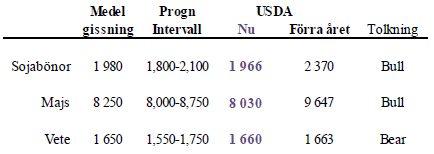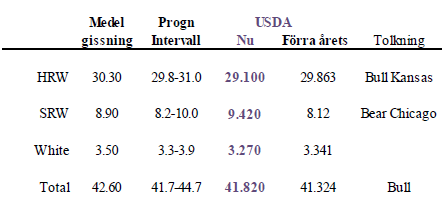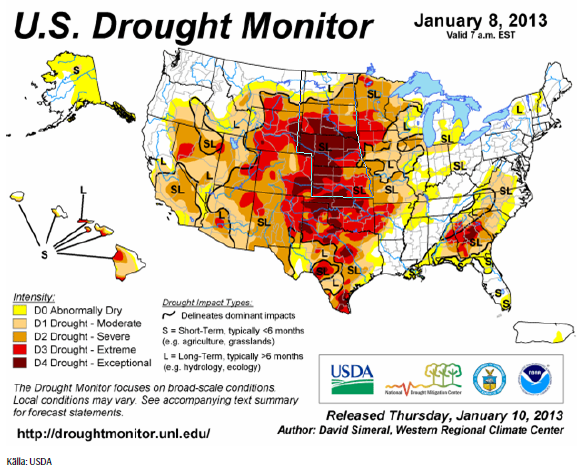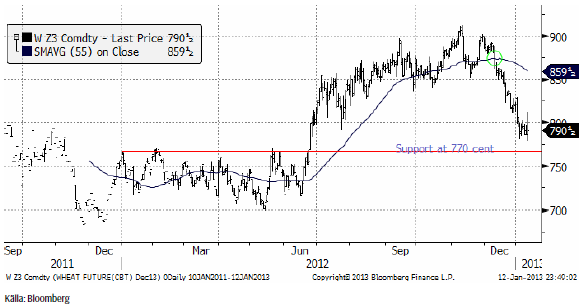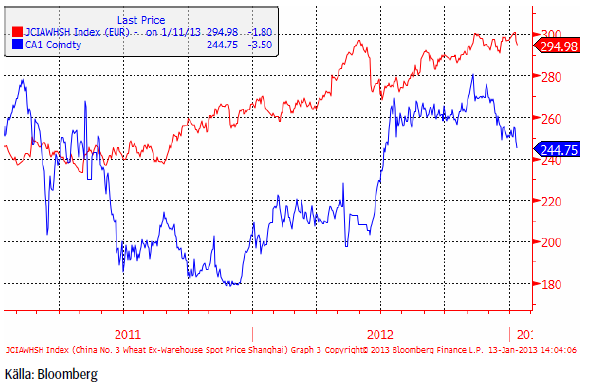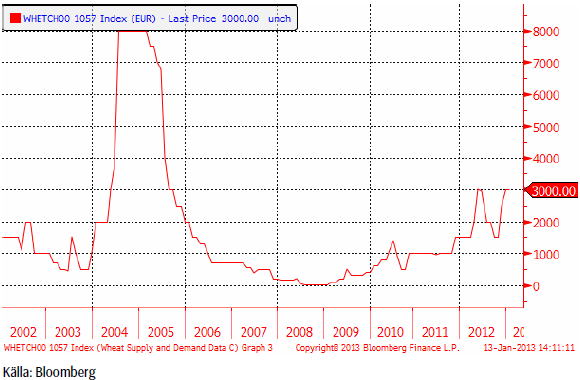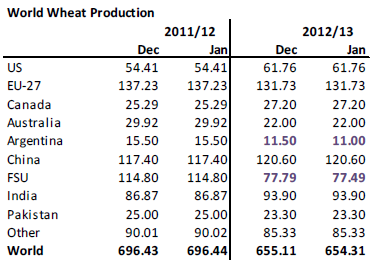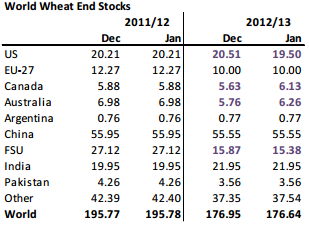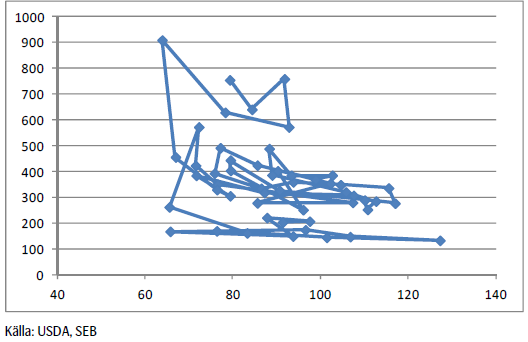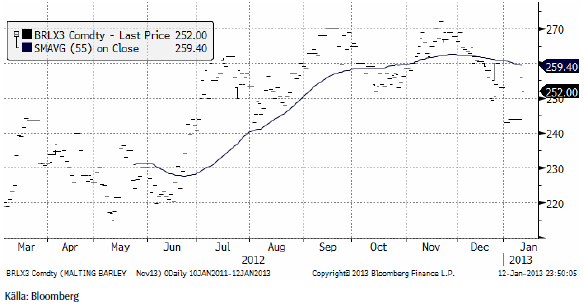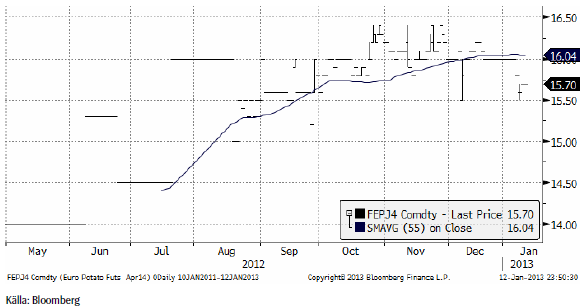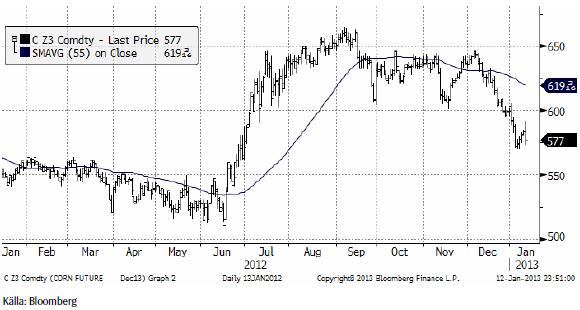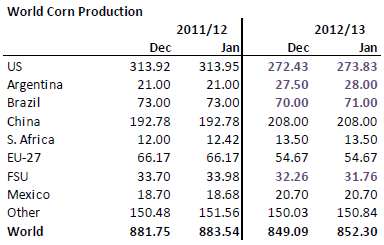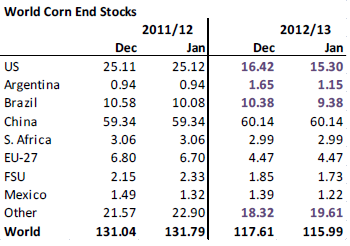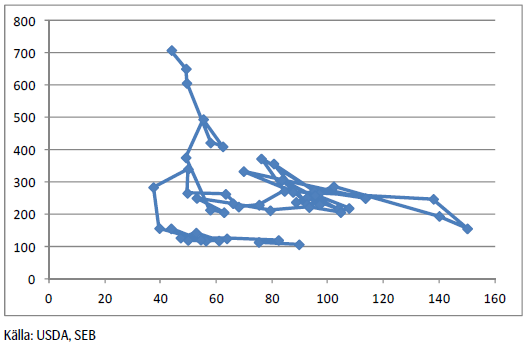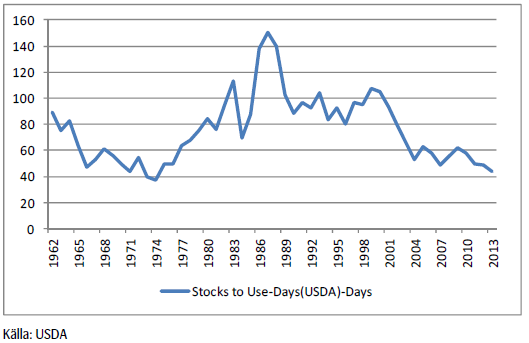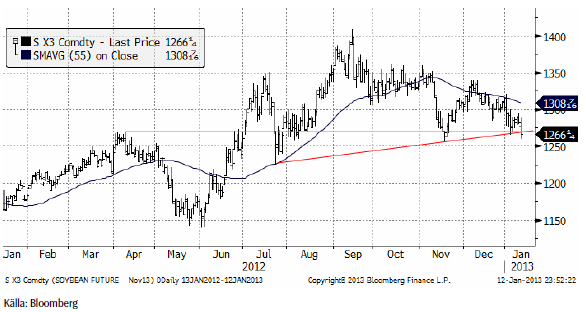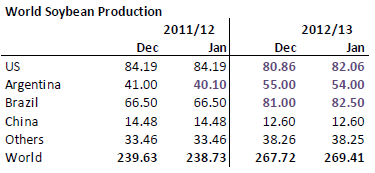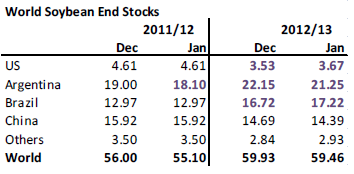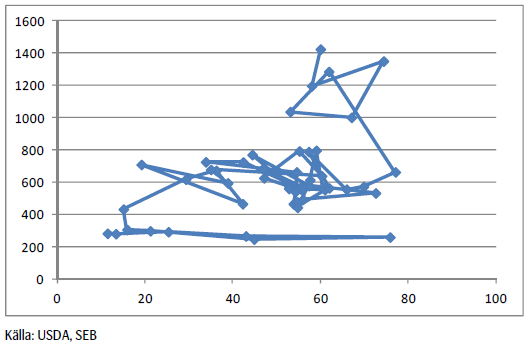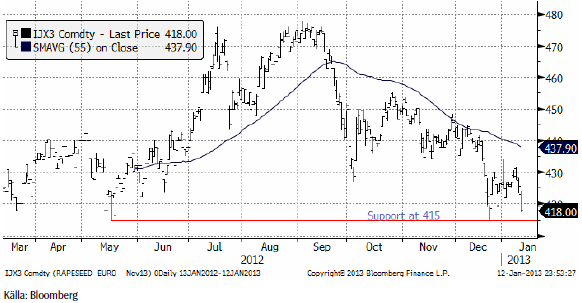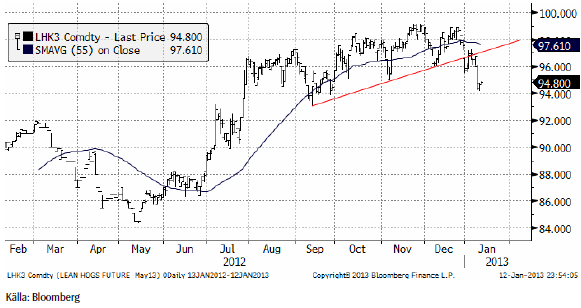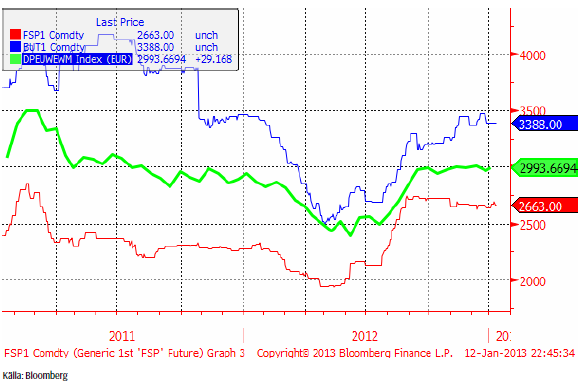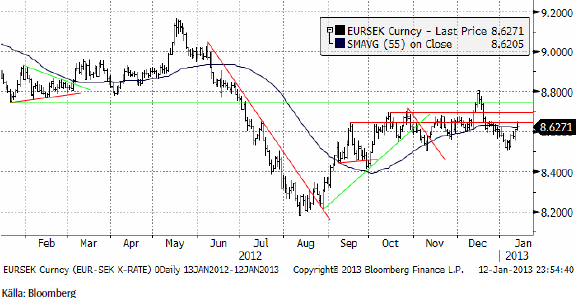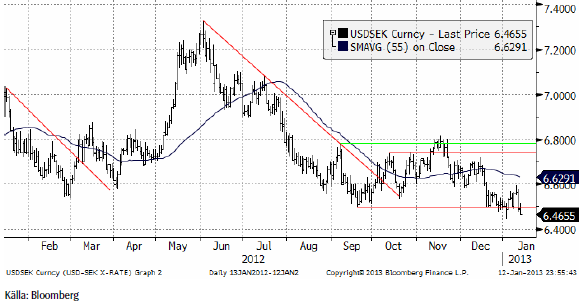Analys
SEB Jordbruksprodukter, 14 januari 2013
 I fredags på den nya tiden 18:00 publicerade det amerikanska jordbruksdepartementet årets första World Agricultural Supply and Demand Estimates (WASDE) och lagerstatistiken per den 1 december samt sådd höstvete-areal. Vi går igenom WASDE-statistiken under respektive råvara längre fram i veckobrevet.
I fredags på den nya tiden 18:00 publicerade det amerikanska jordbruksdepartementet årets första World Agricultural Supply and Demand Estimates (WASDE) och lagerstatistiken per den 1 december samt sådd höstvete-areal. Vi går igenom WASDE-statistiken under respektive råvara längre fram i veckobrevet.
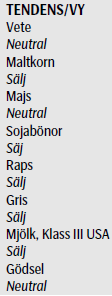 Lagerstatistiken i miljoner bushels visade att det fanns mindre sojabönor och majs i lager i USA än marknaden hade väntat sig. Viktigast för dessa var majs, eftersom lagersituationen där är mest ansträngd efter sommarens torka i USA. Lagren visade sig vara ännu mindre än vad marknaden hade väntat sig. Det betyder att foderefterfrågan inom USA har varit större än vad marknaden hade väntat sig. Etanolproduktion och export har vi ju god koll på. Vi minns också att USDA i september gjorde en märklig uppjustering av lagren (1 september), som vi skrev att vi inte trodde på (att lagret borde vara lägre). Man hade ökat lagret per 1 september med den del som var skördad tidigt, skörden var ju ovanligt tidig, men inte i motsvarande mån minskat skörden resten av hösten.
Lagerstatistiken i miljoner bushels visade att det fanns mindre sojabönor och majs i lager i USA än marknaden hade väntat sig. Viktigast för dessa var majs, eftersom lagersituationen där är mest ansträngd efter sommarens torka i USA. Lagren visade sig vara ännu mindre än vad marknaden hade väntat sig. Det betyder att foderefterfrågan inom USA har varit större än vad marknaden hade väntat sig. Etanolproduktion och export har vi ju god koll på. Vi minns också att USDA i september gjorde en märklig uppjustering av lagren (1 september), som vi skrev att vi inte trodde på (att lagret borde vara lägre). Man hade ökat lagret per 1 september med den del som var skördad tidigt, skörden var ju ovanligt tidig, men inte i motsvarande mån minskat skörden resten av hösten.
Lagren av sojabönor indikerar att priset bör gå upp något för att nå marknadsjämvikten. För vete motiveras något lägre pris, men det är så lite att det nästan är försumbart.
Om vi så går vidare med vetet för att se hur mycket som var sått i miljoner acres, enligt USDA:s statistik, av höstvete, kan vi se att det är väsentligt mindre Hard Red Winter Wheat, den sort som handlas på Kansas City Board of Trade. Det har såtts mindre HRWW än förra året, till och med. HRWW innehåller mer protein än Chicago-sorten, Soft Red Winter Wheat. Det har såtts mer SRWW än väntat och betydligt mer än förra året. Vi kan alltså vänta oss i år att premien för protein ökar i år.
Sammantaget är det en rapport som indikerar högre priser för vete. Möjligtvis kommer detta att locka fram mer sådd av vårvete och i så fall mindre sådd av majs och sojabönor. I vilket fall, sammantaget en rapport som pekar på högre priser på alla dessa grödor.
Vi ändrar nu rekommendationen för vete och majs till neutral från sälj.
Odlingsväder
Torkan i USA håller i sig, som vi ser i den senaste ”Drought Monitor”, som publicerades i torsdags. Sedan förra veckan är det en marginell förbättring i torkan, dvs något lite mindre yta är drabbad av torka.
Sedan förra veckan har alla kategorier av torka (D0 – D4) minskat, som vi ser i nedanstående tabell.
I Kina har det varit extremt kallt vilket fått priset på höstvete att nå en rekordnivå. Mer om det nedan. I England har det regnat extremt mycket den senaste veckan. Höstvetet befaras ha tagit skada. Argentina fick tillbaka torrt väder i veckan (majs, sojabönor).
Vete
Nedan ser vi november (2013) kontraktet, där priset föll kraftigt i fredags, men återhämtade sig och stängde på 217.50, nästan oförändrat på dagen.
Nedan ser vi decemberkontraktet på CBOT. Chicago stängde upp efter fredagens handel, till skillnad från Matif. GASC, den Egyptiska statens huvudsakliga veteimportör, köpte 115,000 ton amerikanskt och kanadensiskt vete i den senaste tendern, som publicerades i veckan. Till nästa tender GASC franskt vete. Det amerikanska vetet är det billigaste i världen, men frågan är om man lyckas exportera allt eftersom Mississippi-floden har stängts på grund av lågt vattenstånd (orsakat av torkan).
Vi ser här en bild på terminskurvorna för Matif och Chicago, båda omräknade till euro per ton.
Av diagrammet ovan ser man att gammal skörd av Matif-vete är avsevärt mycket dyrare än Chicagovetet. Maj-terminen handlas dessutom lägre än mars-terminen. Det säger att den som väntar med att sälja till maj riskerar att få väsentligt sämre betalt – och dessutom får bära ränte- och lagerkostnader fram till dess. Den som vill ta en position på högre priser och har fysiskt vete i lager gör därför sannolikt bäst i att sälja den fysiska varan och istället köpa terminer.
I Kina har priset på vete stigit till en ny rekordnotering. Det har i våra ”mainstream” media helt missats att Kina drabbats av den värsta kylan på över 30 år och den har skadat höstvetet långt söderut i landet. Priset var efter årsskiftet uppe på över 300 euro per ton för spotleverans i Shanghai. I diagrammet är priset omräknat från Renminbi till euro per ton. Vi ser också spotkontraktet på Matif som jämförelse.
Kina har inte varit någon nettoimportör av vete sedan 2004/05, men risken finns att de måste importera mer framöver. I år räknar USDA med att Kina ska importera 3 mt, som vi ser i diagrammet nedan.
De råvaror som Kina blivit blivit nettoimportör av har rusat iväg i pris.
I fredagens WASDE-rapport sänkte USDA produktionsestimatet för skörden i år med 0.8 mt, fördelat i Argentina och Ryssland/Ukraina.
Utgående lager enligt USDA ser vi nedan. Vi ser att det är en liten sänkning. Sänkningar gjordes för USA och Ryssland/Ukraina. Höjningar gjordes däremot för Australien och Kanada på grund av att man antagit lägre export.
Själva WASDE-rapporten innehöll inget speciellt kursdrivande. Förväntad sådd areal, däremot, som vi gick igenom i inledningen till veckobrevet, indikerade att priset ”bör” kunna gå upp.
Ser vi förhållandet mellan pris och utgående lager i ett historiskt perspektiv, ser vi att priset för spotkontraktet (det med kortast återstående löptid) på CBOT ligger ganska mycket i linje med de senaste årens relation mellan utgående lager och pris.
Slutsatsen efter att ha gått igenom såväl den tekniska bilden, som WASDE-rapporten, lager per 1 december och höstvete-areal, är att marknaden bör etablera en botten på de här nivåerna och stabilisera sig. Vi går därför över till en neutral rekommendation. Ytterligare motiv för detta är att situationen i majsmarknaden är ännu mer ”bullish”.
Maltkorn
November 2013-kontraktet fortsätter att hoppa sig framåt. I veckan steg priset upp nästan till 260 euro per ton, men föll i fredags ner till 252 euro. 240 euro är en tydlig stödnivå strax under. Det förefaller som om de allra ivrigaste maltkornsköparna har den som ”fyndnivå”. Vi kan också se att de lite mindre ivriga maltkornsköparna tycks vara villiga att köpa kring 220 euro per ton. Det finns alltså ganska gott om stödnivåer för priset strax under dagens prisnivå för kommande skörd.
Potatis
Potatispriset för leverans i april nästa år (2014) har sjunkit något sedan förra veckan och handlas på 15.70 euro per deciton. Det är i den nedre delen av det prisintervall som potatisen som skördas i höst har handlats till sedan september.
Majs
Majspriset (december 2013) reagerade på fredagens WASDE-rapport med att först stiga och sedan falla. Tekniskt stöd finns på 550 cent i decemberkontraktet, som vi ser i diagrammet nedan. Vi tycker inte att rapporten från USDA motiverar lägre pris.
WASDE-rapportens produktionsestimat ser vi nedan och det är alltså en höjning från december med 3 mt på global basis. Höjningarna gjordes för USA, Argentina och Brasilien.
Utgående lager sänktes på global basis till 116 mt från 117.6 beroende på att man antagit en högre foderefterfrågan och för att lagren per 1 december var lägre än vad USDA tidigare antagit. Att foderefterfrågan var högre under det fjärde kvartalet än vad USDA antagit innebär att den kommer att vara det även under det första och kanske andra kvartalet i år också. Med så pass låga som lagren är, behövs en riktigt stor skörd i år. Och för att det ska ske kan inte priset fortsätta att falla.
Nedanμ ser vi förhållandet mellan lager och pris. Vi ser att priset är exceptionellt högt i ett historiskt perspektiv, men lagren är också exceptionellt låga.
Vi ska titta på lagren i ett historiskt perspektiv nu i termer av dagars konsumtion:
Sammanfattnignsvis: Det behövs en riktigt ordentlig skörd av majs i USA för att utbudet ska återställas. Lagerrapporten tyder på att foderefterfrågan är större än väntat och globala lager är nära rekordlåga nivåer. Vi går därför över till en neutral rekommendation på majsen.
Sojabönor
Efter lager- och WASDE-rapporten i fredags föll priset på sojabönor. Lagerrapporten indikerade högre priser, men WASDE-rapportens utbuds- och efterfrågebalans (sammanfattad som utgående lager) innehöll inget som skrämde marknaden. Priset i förhållande till utgående lager visar att priset ligger något ”högt” i förhållande till väntad lagernivå.
Tekniskt gjorde prisfallet i fredags ett en stödlinje bröts, vilket signalerar att ytterligare prisfall kan väntas de närmaste dagarna då säljarna verkar vara mer motiverade än köparna. 1225 cent / bushel på novemberkontraktet kan kanske tas som en första målkurs.
USDA justerade upp sojabönsproduktionen 2012/13 i fredagens WASDE-rapport. Brasilien höjdes, vilket är i linje med lokala prognoser. USA höjdes också, men Argentina sänktes. USDA sänkte även Argentinas uppskattade skörd förra året, vilket då slår på utgående lager för 12/13.
Nedan ser vi USDA:s uppskattning av utgående lager 2011/12 och prognos för 2012/13. Som vi ser resulterade det i en liten sänkning, främst i USA och Argentina (pga sänkt ingående lager, huvudsakligen).
Nedan ser vi förhållandet mellan pris och förväntade utgående lager 2012/13 i termer av dagars konsumtion. På basis av den här bilden ser vi att priset ser ”högt” ut.
Sammanfattningsvis: Prisfall ner mot 1225 cent på novemberkontraktet ser ut att kunna vara ett riktmärke.
Raps
Rapspriset (november 2013) föll i pris i fredags som en följd av prisfallet i sojabönorna. Tekniskt finns en stödnivå på 415 euro per ton. Det är troligt att den ska testas – och kanske brytas på nedsidan – i veckan som kommer.
Gris
Grispriset (Maj 13), amerikansk Lean Hogs, har brutit en teknisk stödnivå (röd linje i diagrammet nedan). 94 cent per pund var första stödnivån, men antagligen fortsätter priset ner mot 92 cent i första hand.
Mjölk
I diagrammet nedan ser vi tre kurvor.Den gröna linjen är priset på skummjölkspulver i euro per ton på Eurex-börsen. Den blå är priset på smör på Eurex börsen. Priserna på Eurex anges i euro per ton.
Slutligen så den gröna linjen. Den visar priset på helmjölkspulver (WMP) FOB Västeuropa. Källan är USDA och priserna uppdateras varannan vecka. Vi ser att WMP-priset legat stabilt det fjärde kvartalet förra året, med en liten nedgång mot slutet av året. 2013 har dock börjat med en liten prisuppgång.
Det börsbaserade priset i svenska kronor beräknas med formeln:
där
BUT = priset på smör i euro per ton
SMP = priset på skummjölkspulver i euro per ton
FX = växelkursen för EURSEK.
SEB erbjuder, som första bank i världen, sina kunder att prissäkra ovanstående pris (marknad) i kronor per kilo med terminskontrakt.
EURSEK
EURSEK stärktes successivt under veckan som gick och nådde upp till de gamla motståndsnivåerna. Det finns inte mycket ny information som ger anledning till att anta annat än att den ”sidledes” rörelse vi sett de senaste månaderna ska fortsätta.
USDSEK
Dollarn föll mot kronan i veckan som gick. Det är fortsatt instabilt finansiellt och politiskt i USA. Stödnivån från botten i september är bruten och det ser ut som om vi ska vänta oss ytterligare dollarförsvagning i veckan som kommer.
[box]SEB Veckobrev Jordbruksprodukter är producerat av SEB Merchant Banking och publiceras i samarbete och med tillstånd på Råvarumarknaden.se[/box]
Disclaimer
The information in this document has been compiled by SEB Merchant Banking, a division within Skandinaviska Enskilda Banken AB (publ) (“SEB”).
Opinions contained in this report represent the bank’s present opinion only and are subject to change without notice. All information contained in this report has been compiled in good faith from sources believed to be reliable. However, no representation or warranty, expressed or implied, is made with respect to the completeness or accuracy of its contents and the information is not to be relied upon as authoritative. Anyone considering taking actions based upon the content of this document is urged to base his or her investment decisions upon such investigations as he or she deems necessary. This document is being provided as information only, and no specific actions are being solicited as a result of it; to the extent permitted by law, no liability whatsoever is accepted for any direct or consequential loss arising from use of this document or its contents.
About SEB
SEB is a public company incorporated in Stockholm, Sweden, with limited liability. It is a participant at major Nordic and other European Regulated Markets and Multilateral Trading Facilities (as well as some non-European equivalent markets) for trading in financial instruments, such as markets operated by NASDAQ OMX, NYSE Euronext, London Stock Exchange, Deutsche Börse, Swiss Exchanges, Turquoise and Chi-X. SEB is authorized and regulated by Finansinspektionen in Sweden; it is authorized and subject to limited regulation by the Financial Services Authority for the conduct of designated investment business in the UK, and is subject to the provisions of relevant regulators in all other jurisdictions where SEB conducts operations. SEB Merchant Banking. All rights reserved.
Analys
Tightening fundamentals – bullish inventories from DOE

The latest weekly report from the US DOE showed a substantial drawdown across key petroleum categories, adding more upside potential to the fundamental picture.

Commercial crude inventories (excl. SPR) fell by 5.8 million barrels, bringing total inventories down to 415.1 million barrels. Now sitting 11% below the five-year seasonal norm and placed in the lowest 2015-2022 range (see picture below).
Product inventories also tightened further last week. Gasoline inventories declined by 2.1 million barrels, with reductions seen in both finished gasoline and blending components. Current gasoline levels are about 3% below the five-year average for this time of year.
Among products, the most notable move came in diesel, where inventories dropped by almost 4.1 million barrels, deepening the deficit to around 20% below seasonal norms – continuing to underscore the persistent supply tightness in diesel markets.
The only area of inventory growth was in propane/propylene, which posted a significant 5.1-million-barrel build and now stands 9% above the five-year average.
Total commercial petroleum inventories (crude plus refined products) declined by 4.2 million barrels on the week, reinforcing the overall tightening of US crude and products.


Analys
Bombs to ”ceasefire” in hours – Brent below $70

A classic case of “buy the rumor, sell the news” played out in oil markets, as Brent crude has dropped sharply – down nearly USD 10 per barrel since yesterday evening – following Iran’s retaliatory strike on a U.S. air base in Qatar. The immediate reaction was: “That was it?” The strike followed a carefully calibrated, non-escalatory playbook, avoiding direct threats to energy infrastructure or disruption of shipping through the Strait of Hormuz – thus calming worst-case fears.

After Monday morning’s sharp spike to USD 81.4 per barrel, triggered by the U.S. bombing of Iranian nuclear facilities, oil prices drifted sideways in anticipation of a potential Iranian response. That response came with advance warning and caused limited physical damage. Early this morning, both the U.S. President and Iranian state media announced a ceasefire, effectively placing a lid on the immediate conflict risk – at least for now.
As a result, Brent crude has now fallen by a total of USD 12 from Monday’s peak, currently trading around USD 69 per barrel.
Looking beyond geopolitics, the market will now shift its focus to the upcoming OPEC+ meeting in early July. Saudi Arabia’s decision to increase output earlier this year – despite falling prices – has drawn renewed attention considering recent developments. Some suggest this was a response to U.S. pressure to offset potential Iranian supply losses.
However, consensus is that the move was driven more by internal OPEC+ dynamics. After years of curbing production to support prices, Riyadh had grown frustrated with quota-busting by several members (notably Kazakhstan). With Saudi Arabia cutting up to 2 million barrels per day – roughly 2% of global supply – returns were diminishing, and the risk of losing market share was rising. The production increase is widely seen as an effort to reassert leadership and restore discipline within the group.
That said, the FT recently stated that, the Saudis remain wary of past missteps. In 2018, Riyadh ramped up output at Trump’s request ahead of Iran sanctions, only to see prices collapse when the U.S. granted broad waivers – triggering oversupply. Officials have reportedly made it clear they don’t intend to repeat that mistake.
The recent visit by President Trump to Saudi Arabia, which included agreements on AI, defense, and nuclear cooperation, suggests a broader strategic alignment. This has fueled speculation about a quiet “pump-for-politics” deal behind recent production moves.
Looking ahead, oil prices have now retraced the entire rally sparked by the June 13 Israel–Iran escalation. This retreat provides more political and policy space for both the U.S. and Saudi Arabia. Specifically, it makes it easier for Riyadh to scale back its three recent production hikes of 411,000 barrels each, potentially returning to more moderate increases of 137,000 barrels for August and September.
In short: with no major loss of Iranian supply to the market, OPEC+ – led by Saudi Arabia – no longer needs to compensate for a disruption that hasn’t materialized, especially not to please the U.S. at the cost of its own market strategy. As the Saudis themselves have signaled, they are unlikely to repeat previous mistakes.
Conclusion: With Brent now in the high USD 60s, buying oil looks fundamentally justified. The geopolitical premium has deflated, but tensions between Israel and Iran remain unresolved – and the risk of missteps and renewed escalation still lingers. In fact, even this morning, reports have emerged of renewed missile fire despite the declared “truce.” The path forward may be calmer – but it is far from stable.
Analys
A muted price reaction. Market looks relaxed, but it is still on edge waiting for what Iran will do

Brent crossed the 80-line this morning but quickly fell back assigning limited probability for Iran choosing to close the Strait of Hormuz. Brent traded in a range of USD 70.56 – 79.04/b last week as the market fluctuated between ”Iran wants a deal” and ”US is about to attack Iran”. At the end of the week though, Donald Trump managed to convince markets (and probably also Iran) that he would make a decision within two weeks. I.e. no imminent attack. Previously when when he has talked about ”making a decision within two weeks” he has often ended up doing nothing in the end. The oil market relaxed as a result and the week ended at USD 77.01/b which is just USD 6/b above the year to date average of USD 71/b.

Brent jumped to USD 81.4/b this morning, the highest since mid-January, but then quickly fell back to a current price of USD 78.2/b which is only up 1.5% versus the close on Friday. As such the market is pricing a fairly low probability that Iran will actually close the Strait of Hormuz. Probably because it will hurt Iranian oil exports as well as the global oil market.
It was however all smoke and mirrors. Deception. The US attacked Iran on Saturday. The attack involved 125 warplanes, submarines and surface warships and 14 bunker buster bombs were dropped on Iranian nuclear sites including Fordow, Natanz and Isfahan. In response the Iranian Parliament voted in support of closing the Strait of Hormuz where some 17 mb of crude and products is transported to the global market every day plus significant volumes of LNG. This is however merely an advise to the Supreme leader Ayatollah Ali Khamenei and the Supreme National Security Council which sits with the final and actual decision.
No supply of oil is lost yet. It is about the risk of Iran closing the Strait of Hormuz or not. So far not a single drop of oil supply has been lost to the global market. The price at the moment is all about the assessed risk of loss of supply. Will Iran choose to choke of the Strait of Hormuz or not? That is the big question. It would be painful for US consumers, for Donald Trump’s voter base, for the global economy but also for Iran and its population which relies on oil exports and income from selling oil out of that Strait as well. As such it is not a no-brainer choice for Iran to close the Strait for oil exports. And looking at the il price this morning it is clear that the oil market doesn’t assign a very high probability of it happening. It is however probably well within the capability of Iran to close the Strait off with rockets, mines, air-drones and possibly sea-drones. Just look at how Ukraine has been able to control and damage the Russian Black Sea fleet.
What to do about the highly enriched uranium which has gone missing? While the US and Israel can celebrate their destruction of Iranian nuclear facilities they are also scratching their heads over what to do with the lost Iranian nuclear material. Iran had 408 kg of highly enriched uranium (IAEA). Almost weapons grade. Enough for some 10 nuclear warheads. It seems to have been transported out of Fordow before the attack this weekend.
The market is still on edge. USD 80-something/b seems sensible while we wait. The oil market reaction to this weekend’s events is very muted so far. The market is still on edge awaiting what Iran will do. Because Iran will do something. But what and when? An oil price of 80-something seems like a sensible level until something do happen.
-

 Nyheter3 veckor sedan
Nyheter3 veckor sedanMahvie Minerals växlar spår – satsar fullt ut på guld
-

 Nyheter4 veckor sedan
Nyheter4 veckor sedanUppgången i oljepriset planade ut under helgen
-

 Nyheter4 veckor sedan
Nyheter4 veckor sedanLåga elpriser i sommar – men mellersta Sverige får en ökning
-

 Nyheter3 veckor sedan
Nyheter3 veckor sedanOljan, guldet och marknadens oroande tystnad
-

 Analys3 veckor sedan
Analys3 veckor sedanA muted price reaction. Market looks relaxed, but it is still on edge waiting for what Iran will do
-

 Nyheter3 veckor sedan
Nyheter3 veckor sedanJonas Lindvall är tillbaka med ett nytt oljebolag, Perthro, som ska börsnoteras
-

 Analys4 veckor sedan
Analys4 veckor sedanVery relaxed at USD 75/b. Risk barometer will likely fluctuate to higher levels with Brent into the 80ies or higher coming 2-3 weeks
-

 Nyheter3 veckor sedan
Nyheter3 veckor sedanDomstolen ger klartecken till Lappland Guldprospektering


